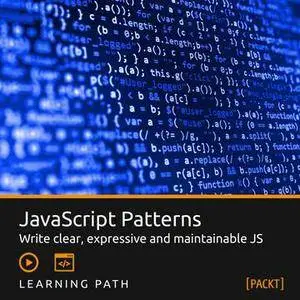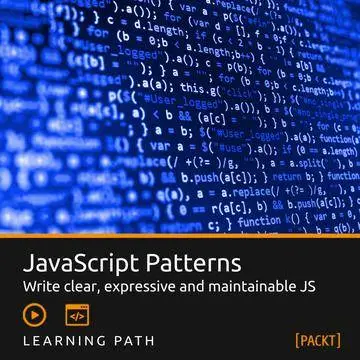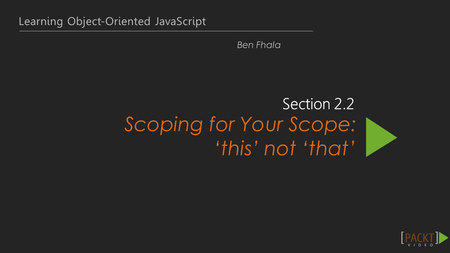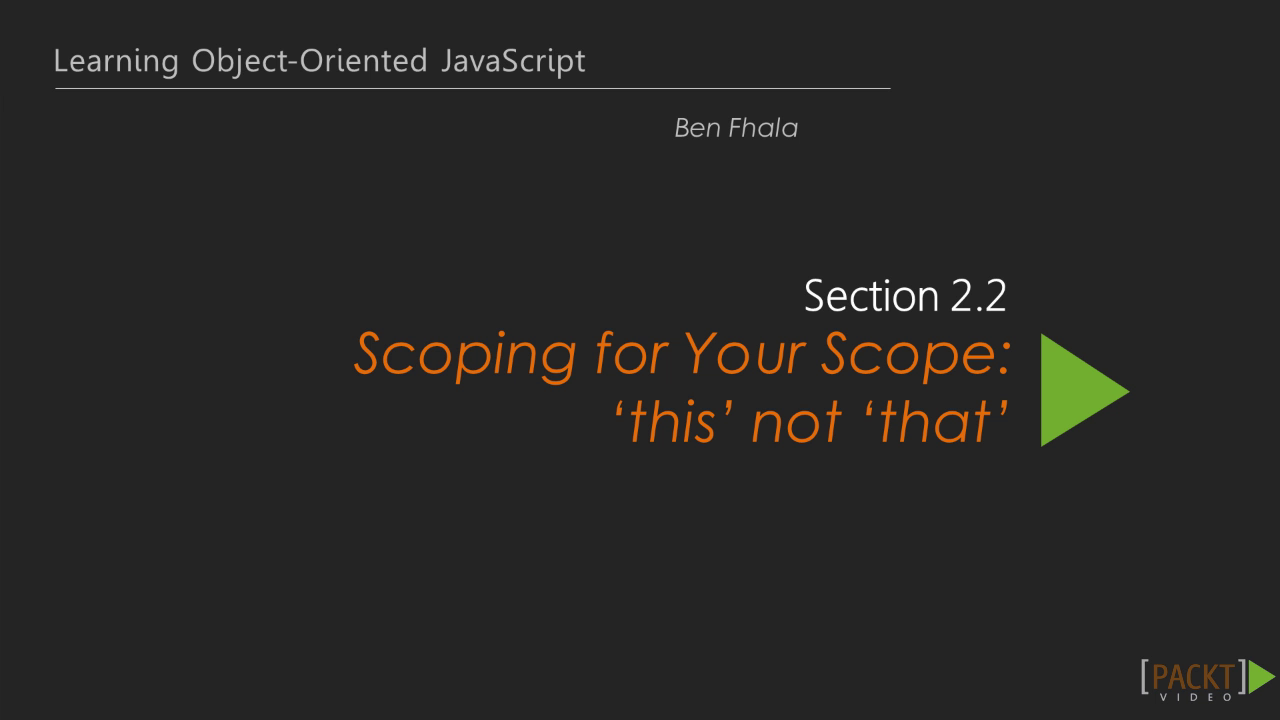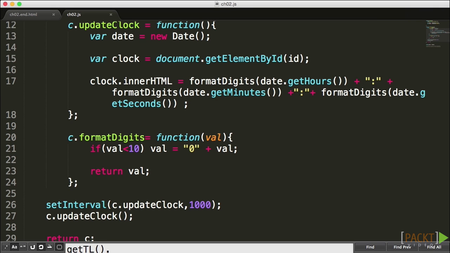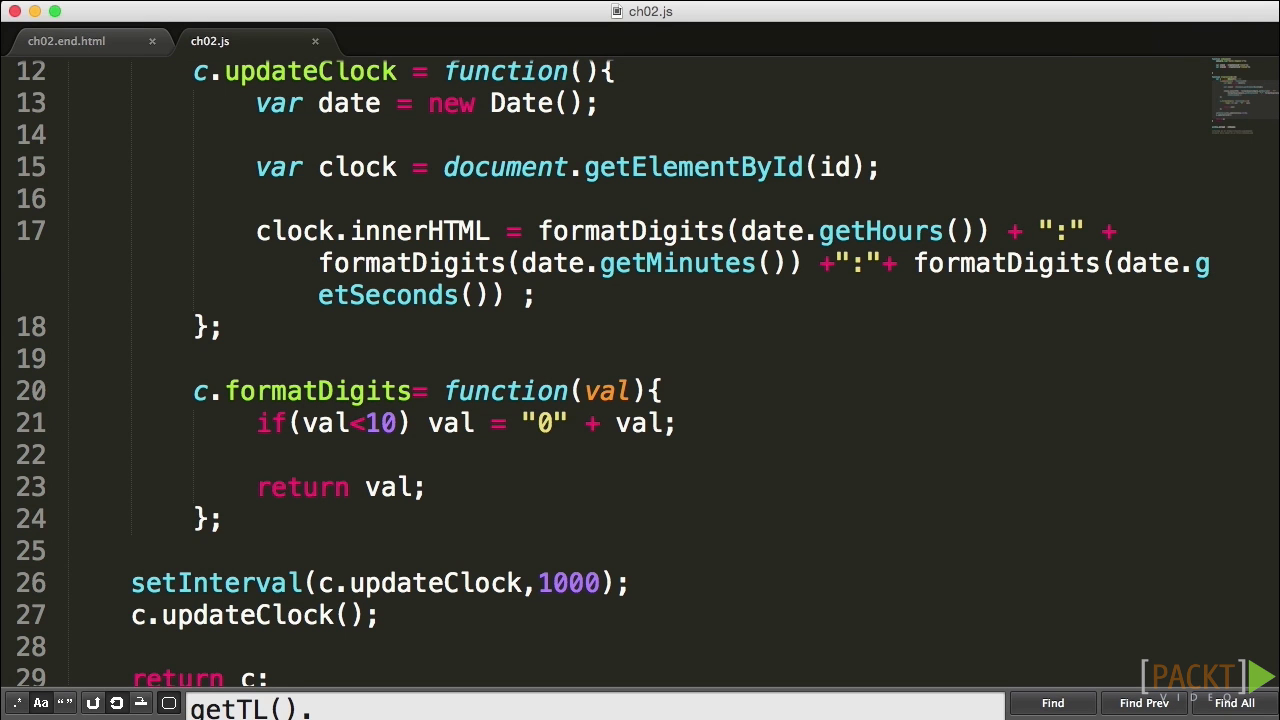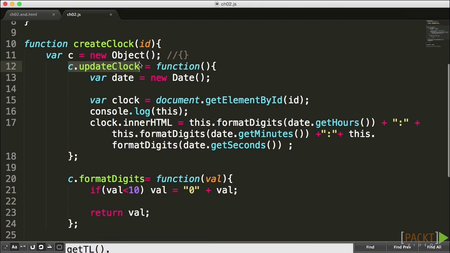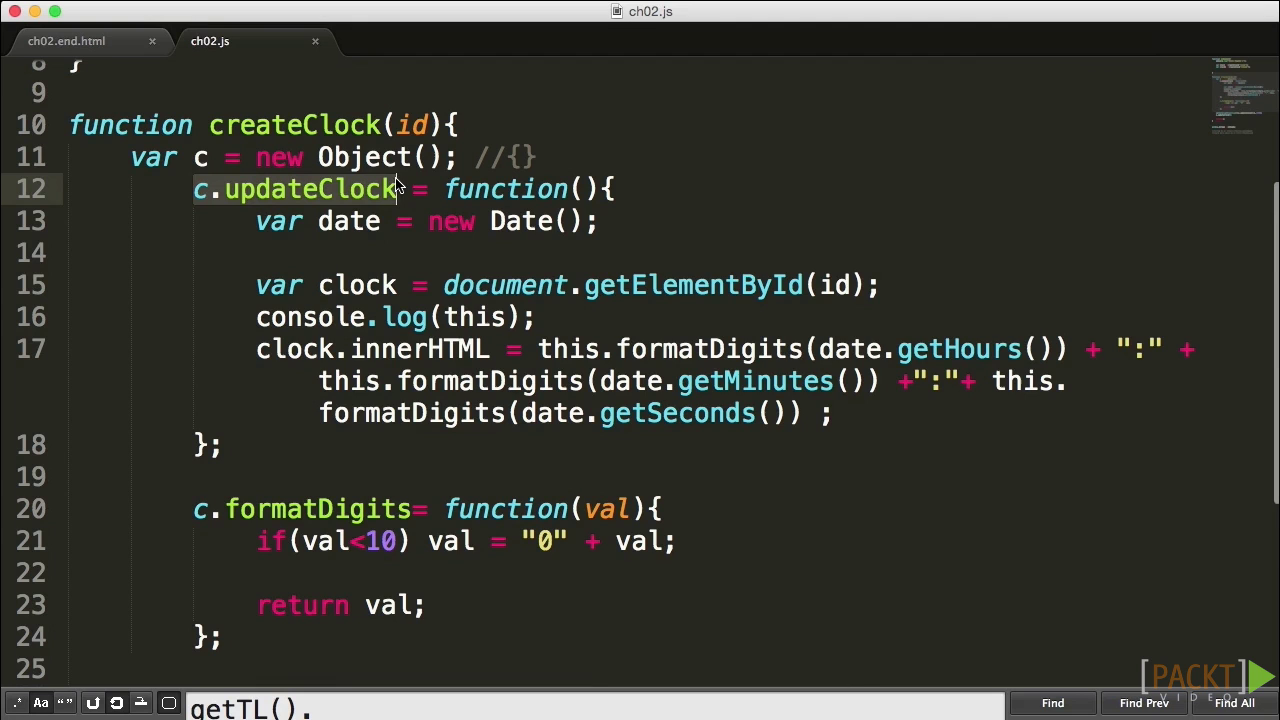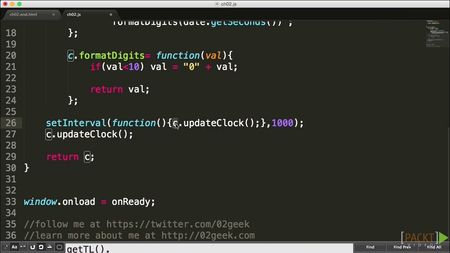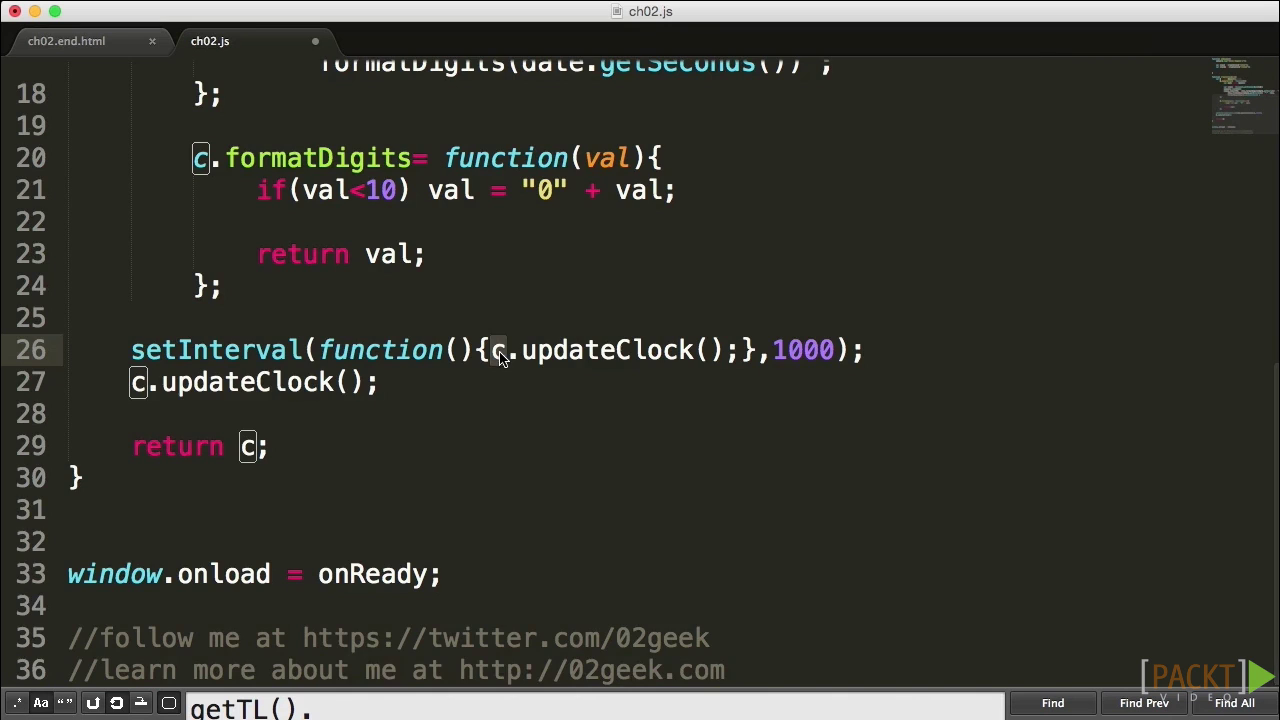PacktPub: Learning Path - JavaScript Patterns (2016)
WEBRip | English | MP4 | 1280 x 720 | AVC ~449 kbps | 30 fps
AAC | 128 Kbps | 44.1 KHz | 2 channels | 07:50:12 | 3.07 GB
Genre: eLearning Video / Development, Programming
WEBRip | English | MP4 | 1280 x 720 | AVC ~449 kbps | 30 fps
AAC | 128 Kbps | 44.1 KHz | 2 channels | 07:50:12 | 3.07 GB
Genre: eLearning Video / Development, Programming
A strong understanding of programming languages helps you to deliver functional solutions quickly, and will reduce your usage of third-party ‘utility’ dependencies like jQuery or lodash. This essential collection of design patterns and best practices will help build your overall understanding of JavaScript as a language, helping you confidently and quickly deliver robust, scalable web applications.Prerequisites: A firm understanding of JavaScript and JavaScript (ES5) syntax
Resources: Code downloads and errata:
Learning Object Oriented JavaScript
Learning JavaScript Data Structures and Algorithms
JavaScript Design Patterns 20 Patterns for Advancing Your JavaScript Skills
Mastering JavaScript Design Patterns: A Practical Introduction to Building Better Applications
JavaScript High Performance
This path navigates across the following products (in sequential order):
Learning Object Oriented JavaScript (2h 47m)
Learning JavaScript Data Structures and Algorithms (3h 15m)
JavaScript Design Patterns 20 Patterns for Advancing Your JavaScript Skills (1h 1m)
Mastering JavaScript Design Patterns: A Practical Introduction to Building Better Applications (2h 10m)
JavaScript High Performance (2h 40m)
Chapter 1 : Learning Object Oriented JavaScript
Setting Up the HTML and CSS
Knowing When the Document is Loaded
Understanding What Objects Are
The Difference between Browsers
Tying Up Loose Ends
Building with Objects
Scoping for Your Scope: ‘this’ not ‘that’
Constructing a Constructor
Reusing Objects
Creating Methods with the Prototype
Augmenting Built-in Objects
Static Properties and Methods
Moving Our Code into a Namespace
Functions that Have Functions
Inheriting Your Parents' Belongings
Creating a Polyfill for Object.create
Overriding Properties and Methods
Creating an Alarm Clock
Turning DIVs into Editable Content in HTML5
Listening to Events
Setting the Alarm Time Dynamically
Dispatching Events
Custom Callbacks
Chapter 2 : Learning JavaScript Data Structures and Algorithms
The Course Overview
What Are Data Structures and Algorithms?
Why Use Data Structures in JavaScript?
Course Format and Datasets Contexts
Introduction to Arrays
Exploring Linked Lists
Introduction to Sets
All about Queues
Exploring Stacks
Introduction to Binary Trees
Exploring Graphs
Describing Algorithms with Big-O Notation
Pathfinding Algorithms
Sorting
Searching
Chapter 3 : JavaScript Design Patterns 20 Patterns for Advancing Your JavaScript Skills
The Course Overview
The Problem with the Global Scope
Moving to One Object and Namespace
The Module Design Pattern
The Module Reveal Pattern
Controlling the Global Access Completely
The Singleton Design Pattern
The Factory Design Pattern
The Abstract Factory Design Pattern
The Builder Design Pattern
The Builder Design Pattern Continued
The Prototype Design Pattern
Abstracting Our Singleton
The Adapter Design Pattern
The Composite Design Pattern
The Decorator Design Pattern
The Fly Weight Design Pattern
The Façade Design Pattern
Getting Things Working Again
The Bridge Design Pattern
The Proxy Design Pattern
The Chain of Responsibility – Part 1
The Chain of Responsibility – Part 2
The Observer Design Pattern – Adding and Dispatching Events
The Observer Design Pattern – Removing Events
The State Design Pattern
Chapter 4 : Mastering JavaScript Design Patterns: A Practical Introduction to Building Better Applications
The Course Overview
Software Design Patterns and Antipatterns
JavaScript Patterns Specifics
Bootstrapping the Project
Adding the Play Functionality
Encapsulating Information
Abstracting Manipulation with DOM Events and Elements
Creating an Adapter to Set Intervals Using Seconds
Using Different Ways to Match Conditions
Modularizing the Application Using Namespaces
Modularizing the Application Using AMD and Require.js
Communication Between Modules
ES6 Modules
Decoupling the Tracks Queue from the Tracks Player
Treating Each Track as a Separate Component
Adding the PubSub Functionality to Tracks
Enabling Track Play and Highlighting the Active Track
Decoupling the Track Model from the View
Formatting Track Time: Two-way Data Binding
Adding a Few Types of Tracks
Implementing Track Removal
Iterating Over Tracks Using a Generator
Iterating Over Tracks Using an Iterator
Adding Nested Tracks and Displaying Them
Fixing the Queue to Work with Nested Tracks
Creating the Server Using Node.js
Returning the Tracks Queue from the Server
Loading Tracks from the Server
Replacing Callbacks with Promises
Binding a Function to a Custom Context
Loading Tracks' Additional Data from the Server
Caching Data Loaded from the Server
Checking for Track Data with a Fallback
Storing Common Tracks Data in Shared Objects
Adding Different Skins for the Player Header
Improving Testability by Inversion of Control
Forcing Function Argument Types
Fixing Models to Support Any String as Attribute Name
Chapter 5 : JavaScript High Performance
Course Overview
Caching Your Scripts
Creating a Cache Buster
Minifying Your Output
Always Declare Your Variables
Creating Location References
Condensing var Definitions
Comparing Explicitly When Appropriate
Using String Accumulator-style
Building Strings with Arrays
Avoiding eval for Object References
Talking to Functions
Avoiding eval
Reducing the Use of Anonymous Functions
OOP – Defining Class Methods and Properties
Picking the Right Loop for the Task
Simplifying Your Loops – Round 1
Reducing the Loop Footprint
Loops, Arrays, and Memory Leaks
Preallocating Size to an Array
Avoiding the Unnecessary
Putting Code Where It Should Be
Clearing Circular References
Using Less Events to Do More
Trading Smoothness for Speed
Clearing Memory Leaks by Always Clearing Intervals
How to Avoid Running Multiple Intervals
Reducing DOM Calls
Reducing Document Reflows
Making It Animate Smoothly
Changing Classes and Not Styles
Adding Scripts as You Need Them Dynamically
Cutting Traveling with HTML5 Validation
Moving Data Processing to the Client Side
What Data Types to Use?
Caching Data
The Issue with Working Directly with HTML Collections
Converting Collection Objects into Arrays
FPS and High Resolution Time – HRT
JavaScript Profiling and Memory Leaks
Setting Up the HTML and CSS
Knowing When the Document is Loaded
Understanding What Objects Are
The Difference between Browsers
Tying Up Loose Ends
Building with Objects
Scoping for Your Scope: ‘this’ not ‘that’
Constructing a Constructor
Reusing Objects
Creating Methods with the Prototype
Augmenting Built-in Objects
Static Properties and Methods
Moving Our Code into a Namespace
Functions that Have Functions
Inheriting Your Parents' Belongings
Creating a Polyfill for Object.create
Overriding Properties and Methods
Creating an Alarm Clock
Turning DIVs into Editable Content in HTML5
Listening to Events
Setting the Alarm Time Dynamically
Dispatching Events
Custom Callbacks
Chapter 2 : Learning JavaScript Data Structures and Algorithms
The Course Overview
What Are Data Structures and Algorithms?
Why Use Data Structures in JavaScript?
Course Format and Datasets Contexts
Introduction to Arrays
Exploring Linked Lists
Introduction to Sets
All about Queues
Exploring Stacks
Introduction to Binary Trees
Exploring Graphs
Describing Algorithms with Big-O Notation
Pathfinding Algorithms
Sorting
Searching
Chapter 3 : JavaScript Design Patterns 20 Patterns for Advancing Your JavaScript Skills
The Course Overview
The Problem with the Global Scope
Moving to One Object and Namespace
The Module Design Pattern
The Module Reveal Pattern
Controlling the Global Access Completely
The Singleton Design Pattern
The Factory Design Pattern
The Abstract Factory Design Pattern
The Builder Design Pattern
The Builder Design Pattern Continued
The Prototype Design Pattern
Abstracting Our Singleton
The Adapter Design Pattern
The Composite Design Pattern
The Decorator Design Pattern
The Fly Weight Design Pattern
The Façade Design Pattern
Getting Things Working Again
The Bridge Design Pattern
The Proxy Design Pattern
The Chain of Responsibility – Part 1
The Chain of Responsibility – Part 2
The Observer Design Pattern – Adding and Dispatching Events
The Observer Design Pattern – Removing Events
The State Design Pattern
Chapter 4 : Mastering JavaScript Design Patterns: A Practical Introduction to Building Better Applications
The Course Overview
Software Design Patterns and Antipatterns
JavaScript Patterns Specifics
Bootstrapping the Project
Adding the Play Functionality
Encapsulating Information
Abstracting Manipulation with DOM Events and Elements
Creating an Adapter to Set Intervals Using Seconds
Using Different Ways to Match Conditions
Modularizing the Application Using Namespaces
Modularizing the Application Using AMD and Require.js
Communication Between Modules
ES6 Modules
Decoupling the Tracks Queue from the Tracks Player
Treating Each Track as a Separate Component
Adding the PubSub Functionality to Tracks
Enabling Track Play and Highlighting the Active Track
Decoupling the Track Model from the View
Formatting Track Time: Two-way Data Binding
Adding a Few Types of Tracks
Implementing Track Removal
Iterating Over Tracks Using a Generator
Iterating Over Tracks Using an Iterator
Adding Nested Tracks and Displaying Them
Fixing the Queue to Work with Nested Tracks
Creating the Server Using Node.js
Returning the Tracks Queue from the Server
Loading Tracks from the Server
Replacing Callbacks with Promises
Binding a Function to a Custom Context
Loading Tracks' Additional Data from the Server
Caching Data Loaded from the Server
Checking for Track Data with a Fallback
Storing Common Tracks Data in Shared Objects
Adding Different Skins for the Player Header
Improving Testability by Inversion of Control
Forcing Function Argument Types
Fixing Models to Support Any String as Attribute Name
Chapter 5 : JavaScript High Performance
Course Overview
Caching Your Scripts
Creating a Cache Buster
Minifying Your Output
Always Declare Your Variables
Creating Location References
Condensing var Definitions
Comparing Explicitly When Appropriate
Using String Accumulator-style
Building Strings with Arrays
Avoiding eval for Object References
Talking to Functions
Avoiding eval
Reducing the Use of Anonymous Functions
OOP – Defining Class Methods and Properties
Picking the Right Loop for the Task
Simplifying Your Loops – Round 1
Reducing the Loop Footprint
Loops, Arrays, and Memory Leaks
Preallocating Size to an Array
Avoiding the Unnecessary
Putting Code Where It Should Be
Clearing Circular References
Using Less Events to Do More
Trading Smoothness for Speed
Clearing Memory Leaks by Always Clearing Intervals
How to Avoid Running Multiple Intervals
Reducing DOM Calls
Reducing Document Reflows
Making It Animate Smoothly
Changing Classes and Not Styles
Adding Scripts as You Need Them Dynamically
Cutting Traveling with HTML5 Validation
Moving Data Processing to the Client Side
What Data Types to Use?
Caching Data
The Issue with Working Directly with HTML Collections
Converting Collection Objects into Arrays
FPS and High Resolution Time – HRT
JavaScript Profiling and Memory Leaks
Release Date: September 2016
More Info: Salepage
also You can watch my other last: Programming-posts
General
Complete name : 07 - Scoping for Your Scope - ‘this’ not ‘that’.mp4
Format : MPEG-4
Format profile : Base Media
Codec ID : isom
File size : 34.4 MiB
Duration : 7mn 34s
Overall bit rate mode : Variable
Overall bit rate : 634 Kbps
Writing application : Lavf56.36.100
Video
ID : 2
Format : AVC
Format/Info : Advanced Video Codec
Format profile : High@L4.0
Format settings, CABAC : Yes
Format settings, ReFrames : 5 frames
Codec ID : avc1
Codec ID/Info : Advanced Video Coding
Duration : 7mn 34s
Bit rate : 499 Kbps
Nominal bit rate : 461 Kbps
Width : 1 280 pixels
Height : 720 pixels
Display aspect ratio : 16:9
Frame rate mode : Constant
Frame rate : 30.000 fps
Color space : YUV
Chroma subsampling : 4:2:0
Bit depth : 8 bits
Scan type : Progressive
Bits/(Pixel*Frame) : 0.018
Stream size : 27.0 MiB (79%)
Writing library : x264 core 146 r2538 121396c
Encoding settings : cabac=1 / ref=6 / deblock=1:0:0 / analyse=0x3:0x111 / me=hex / subme=7 / psy=1 / psy_rd=1.00:0.00 / mixed_ref=1 / me_range=16 / chroma_me=1 / trellis=1 / 8x8dct=1 / cqm=0 / deadzone=21,11 / fast_pskip=1 / chroma_qp_offset=-2 / threads=4 / lookahead_threads=1 / sliced_threads=0 / nr=0 / decimate=1 / interlaced=0 / bluray_compat=0 / stitchable=1 / constrained_intra=0 / bframes=16 / b_pyramid=1 / b_adapt=1 / b_bias=0 / direct=1 / weightb=1 / open_gop=0 / weightp=2 / keyint=60 / keyint_min=20 / scenecut=40 / intra_refresh=0 / rc_lookahead=40 / rc=abr / mbtree=1 / bitrate=461 / ratetol=1.0 / qcomp=0.60 / qpmin=10 / qpmax=50 / qpstep=4 / vbv_maxrate=2500 / vbv_bufsize=5000 / nal_hrd=none / filler=0 / ip_ratio=1.41 / aq=1:1.00
Audio
ID : 1
Format : AAC
Format/Info : Advanced Audio Codec
Format profile : LC
Codec ID : 40
Duration : 7mn 34s
Duration_LastFrame : -22ms
Bit rate mode : Variable
Bit rate : 128 Kbps
Maximum bit rate : 2 500 Kbps
Channel(s) : 2 channels
Channel positions : Front: L R
Sampling rate : 44.1 KHz
Compression mode : Lossy
Delay relative to video : 67ms
Stream size : 6.94 MiB (20%)
Complete name : 07 - Scoping for Your Scope - ‘this’ not ‘that’.mp4
Format : MPEG-4
Format profile : Base Media
Codec ID : isom
File size : 34.4 MiB
Duration : 7mn 34s
Overall bit rate mode : Variable
Overall bit rate : 634 Kbps
Writing application : Lavf56.36.100
Video
ID : 2
Format : AVC
Format/Info : Advanced Video Codec
Format profile : High@L4.0
Format settings, CABAC : Yes
Format settings, ReFrames : 5 frames
Codec ID : avc1
Codec ID/Info : Advanced Video Coding
Duration : 7mn 34s
Bit rate : 499 Kbps
Nominal bit rate : 461 Kbps
Width : 1 280 pixels
Height : 720 pixels
Display aspect ratio : 16:9
Frame rate mode : Constant
Frame rate : 30.000 fps
Color space : YUV
Chroma subsampling : 4:2:0
Bit depth : 8 bits
Scan type : Progressive
Bits/(Pixel*Frame) : 0.018
Stream size : 27.0 MiB (79%)
Writing library : x264 core 146 r2538 121396c
Encoding settings : cabac=1 / ref=6 / deblock=1:0:0 / analyse=0x3:0x111 / me=hex / subme=7 / psy=1 / psy_rd=1.00:0.00 / mixed_ref=1 / me_range=16 / chroma_me=1 / trellis=1 / 8x8dct=1 / cqm=0 / deadzone=21,11 / fast_pskip=1 / chroma_qp_offset=-2 / threads=4 / lookahead_threads=1 / sliced_threads=0 / nr=0 / decimate=1 / interlaced=0 / bluray_compat=0 / stitchable=1 / constrained_intra=0 / bframes=16 / b_pyramid=1 / b_adapt=1 / b_bias=0 / direct=1 / weightb=1 / open_gop=0 / weightp=2 / keyint=60 / keyint_min=20 / scenecut=40 / intra_refresh=0 / rc_lookahead=40 / rc=abr / mbtree=1 / bitrate=461 / ratetol=1.0 / qcomp=0.60 / qpmin=10 / qpmax=50 / qpstep=4 / vbv_maxrate=2500 / vbv_bufsize=5000 / nal_hrd=none / filler=0 / ip_ratio=1.41 / aq=1:1.00
Audio
ID : 1
Format : AAC
Format/Info : Advanced Audio Codec
Format profile : LC
Codec ID : 40
Duration : 7mn 34s
Duration_LastFrame : -22ms
Bit rate mode : Variable
Bit rate : 128 Kbps
Maximum bit rate : 2 500 Kbps
Channel(s) : 2 channels
Channel positions : Front: L R
Sampling rate : 44.1 KHz
Compression mode : Lossy
Delay relative to video : 67ms
Stream size : 6.94 MiB (20%)
Screenshots
Exclusive eLearning Videos ParRus-blog ← add to bookmarks


